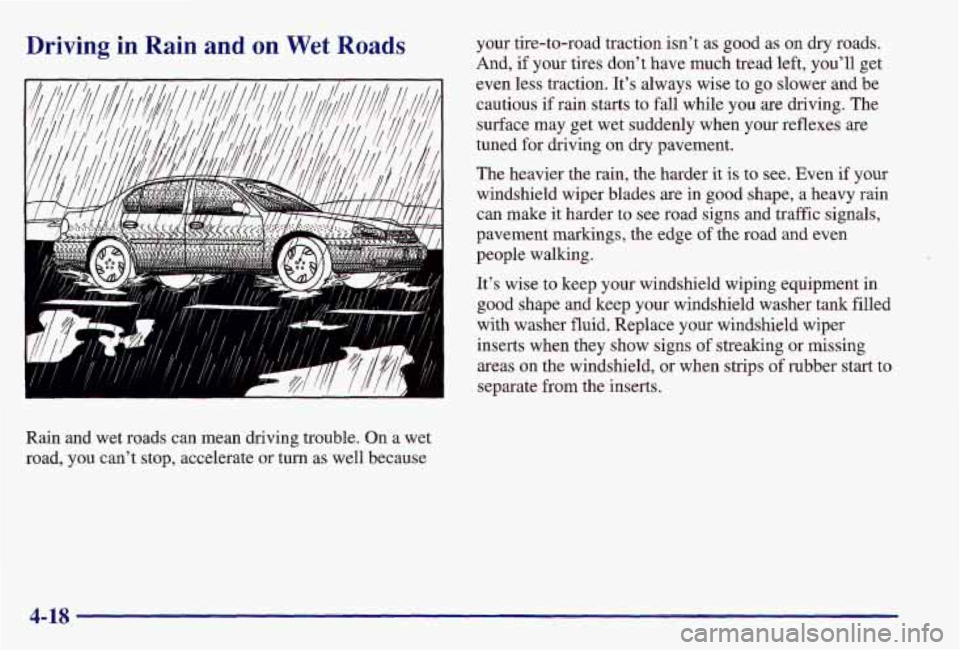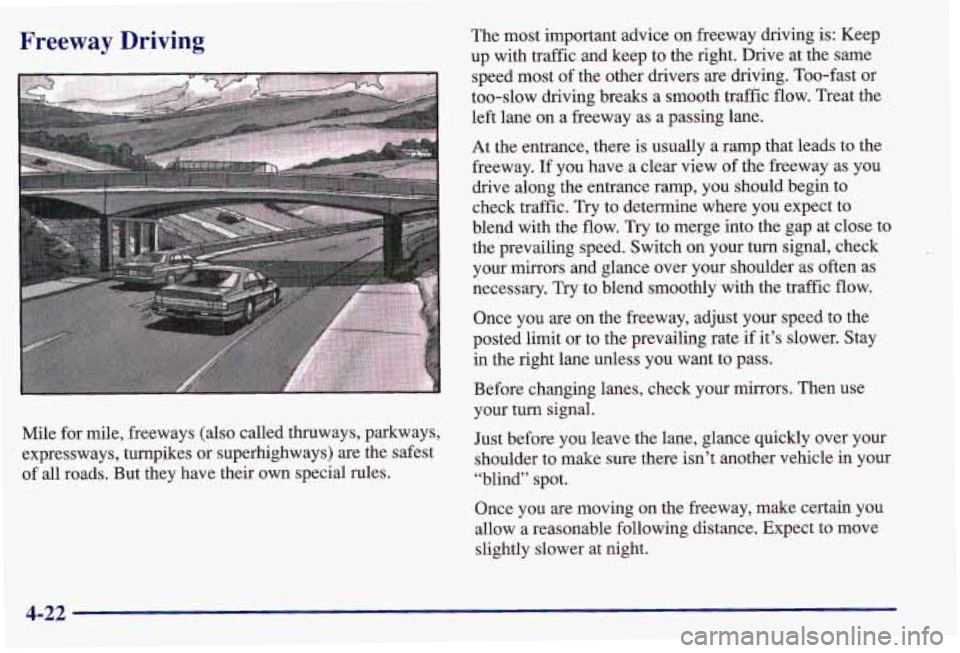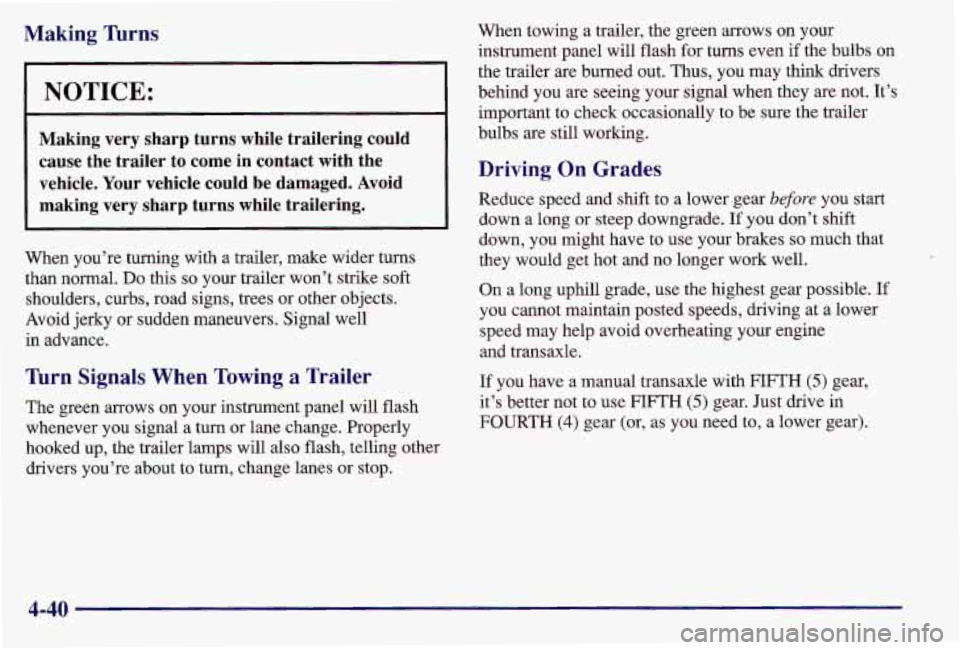Page 169 of 371

Driving in Rain and on Wet Roads
Rain and wet roads can mean driving trouble. On a wet
road, you can’t stop, accelerate or turn as well because your
tire-to-road traction isn’t as good as on dry roads.
And, if your tires don’t have much tread left, you’ll get
even less traction. It’s always wise to go slower and be
cautious if rain starts to fall while you are driving. The
surface may get wet suddenly when your reflexes are
tuned for driving on dry pavement.
The heavier the rain, the harder it
is to see. Even if your
windshield wiper blades are in good shape, a heavy rain
can make it harder to see road signs and traffic signals,
pavement markings, the edge
of the road and even
people walking.
It’s wise to keep your windshield wiping equipment in
good shape and keep your windshield washer tank filled
with washer
fluid. Replace your windshield wiper
inserts when they show signs of streaking or missing
areas on the windshield, or when strips of rubber start to
separate from the inserts.
4- 18
Page 172 of 371
City Driving
One of the biggest problems with city streets is the
amount of traffic on them. You’ll want to watch out for
what the other drivers are doing and pay attention to
traffic signals. Here are ways to increase your safety
in city driving:
0 Know the best way to get to where you are going.
Get a city map and plan your trip into an unknown
part of the city just as you would for a
cross-country trip.
0 Try to use the freeways that rim and crisscross most
large cities. You’ll save time and energy. (See the
next part, “Freeway Driving.”)
Treat a green light as a warning signal. A traffic light is
there because the corner is busy enough to need it.
When a light
turns green, and just before you start to e
move, check both ways for vehicles that have not
cleared the intersection or may be running the red light.
4-21
Page 173 of 371

Freeway Driving
Mile for mile, freeways (also called thruways, parkways,
expressways, turnpikes or superhighways)
are the safest
of all roads. But they have their own special rules. The most
important advice on freeway driving is: Keep
up with traffic and keep to the right. Drive at the same
speed most
of the other drivers are driving. Too-fast or
too-slow driving breaks a smooth traffic flow. Treat the
left lane on a freeway as a passing lane.
At the entrance, there
is usually a ramp that leads to the
freeway.
If you have a clear view of the freeway as you
drive along the entrance ramp, you should begin to
check traffic. Try to determine where you expect to
blend with the flow. Try to merge into the gap at close to
the prevailing speed. Switch on your turn signal, check
your mirrors and glance over your shoulder as often as
necessary. Try to blend smoothly with the traffic flow.
Once you are on the freeway, adjust your speed to the
posted limit or to the prevailing rate if it’s slower. Stay
in the right lane unless you want
to pass.
Before changing lanes, check your mirrors. Then use
your turn signal.
Just before you leave the lane, glance quickly over your
shoulder to make sure there isn’t another vehicle in your
“blind” spot.
Once you
are moving on the freeway, make certain you
allow a reasonable following distance. Expect to move
slightly slower at night.
4-22
Page 191 of 371

Making Turns
I NOTICE: 1
Making very sharp turns while trailering could cause the trailer to come in contact with the vehicle. Your vehicle could be damaged. Avoid
making very sharp turns while trailering.
1
When you’re turning with a trailer, make wider turns
than normal.
Do this so your trailer won’t strike soft
shoulders, curbs, road signs, trees or other objects.
Avoid jerky or sudden maneuvers. Signal well
in advance.
Turn Signals When Towing a Trailer
The green arrows on your instrument panel will flash
whenever you signal a turn or lane change. Properly
hooked up, the trailer lamps will also flash, telling other
drivers you’re about to turn, change lanes
or stop. When
towing a trailer, the green arrows on your
instrument panel will flash for turns even
if the bulbs on
the trailer are burned out. Thus, you may think drivers
behind you are seeing your signal when they are not. It’s
important
to check occasionally to be sure the trailer
bulbs are still working.
Driving On Grades
Reduce speed and shift to a lower gear before you start
down a long or steep downgrade.
If you don’t shift
down, you might have to use your brakes
so much that
they would get hot and no longer work well.
On a long uphill grade, use the highest gear possible. If
you cannot maintain posted speeds, driving at a lower
speed may help avoid overheating your engine
and transaxle.
If you have a manual transaxle with FIFTH
(5) gear,
it’s better not to use FIFTH
(5) gear. Just drive in
FOURTH
(4) gear (or, as you need to, a lower gear).
4-40
Page 195 of 371
Hazard Warning Flashers
Your hazard warning flashers let you warn others. They
also let police know you have a problem. Your front and
rear turn signal lamps will flash
on and off. Move the switch
to the right
to make your front and rear
turn signal lamps flash on
and
off.
Your hazard warning flashers work no matter what
position your key is in, and even if the key isn’t in.
To turn off the flashers, move the switch to the left.
When the hazard warning flashers are on, your turn
signals won’t
work.
Other Warning Devices
If you carry reflective triangles, you can set one up at
the side of the road about 300 feet (100 m) behind
your vehicle.
Page 265 of 371
Rear Exterior Lamps
A. Stop/Taillamp
B.
Turn Signal Lamp
C. Back-up Lamp
Center High-Mounted Stop Lamp
1. Use a flat screwdriver to gently release the tabs on
the trim cover.
?. Using a flat screwdriver, remove the screws holding
the bulb assembly.
6-38
Page 266 of 371
3. Use a flat screwdriver to release the tabs holding the
socket in place.
4. Gently remove and replace the bulbs.
5. Reverse this procedure to reassemble the lamp.
Turn Signal and Stop/Taillamp
Bulb Replacement
For the type of bulb, see “Replacement Bulbs” in
the Index.
Back-up Lamps
1. Open the trunk lid and locate the back-up lamps or1
2. Gently remove the bulbs from the socket.
3. Replace the bulb in the socket.
4. Close the trunk lid.
the
inside of the lid.
1. Pull back the trunk trim.
2. Remove the four wing bolts which fasten the
taillamp lens to the vehicle,
6-39
Page 287 of 371
Instrument Panel Fuse Block
I TURN 1 CRUISE
PWR ST
+ RDO IGN WIPER
I HTR-A/C I 02
DR LK 1
PRNDL I INST 1 INSTLPS
DR LK2 STOP HA2 RR DEF
I I
I 0 r U
The main fuse panel is located on the left side of the
instrument panel.
To access the fuses, open the fuse
panel door. Fuse
PWR WDO
TURN
Usage
Power Window (Circuit Breaker)
Turn Signal Lamps
6-60